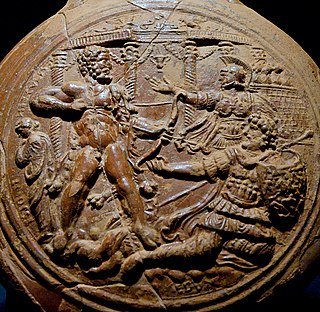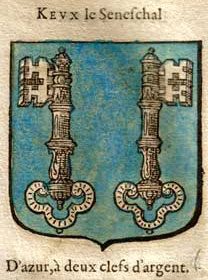Related Research Articles

In Norse mythology, Sleipnir is an eight-legged horse ridden by Odin. Sleipnir is attested in the Poetic Edda, compiled in the 13th century from earlier traditional sources, and the Prose Edda, written in the 13th century by Snorri Sturluson. In both sources, Sleipnir is Odin's steed, is the child of Loki and Svaðilfari, is described as the best of all horses, and is sometimes ridden to the location of Hel. The Prose Edda contains extended information regarding the circumstances of Sleipnir's birth, and details that he is grey in color.

In Greek mythology, Laomedon was a Trojan king, son of Ilus and thus nephew of Ganymede and Assaracus.

Lionel of Antwerp, Duke of Clarence,, was an English prince, Earl of Ulster jure uxoris from 1347, Duke of Clarence from 1362, Guardian of England in 1345–46, Lord Lieutenant of Ireland in 1361–66, Knight of the Garter from 1361, second surviving son of King Edward III of England and Philippa of Hainault. He was named after his birthplace, at Antwerp in the Duchy of Brabant.

Jousting is a medieval and renaissance martial game or hastilude between two combatants either on horse or on foot. The joust became an iconic characteristic of the knight in Romantic medievalism.

Kalevipoeg is a 19th-century epic poem by Friedrich Reinhold Kreutzwald which has since been considered the Estonian national epic.

Eltham Palace is a large house at Eltham in southeast London, England, within the Royal Borough of Greenwich. The house consists of the medieval great hall of a former royal residence, to which an Art Deco extension was added in the 1930s. The hammerbeam roof of the great hall is the third-largest of its type in England, and the Art Deco interior of the house has been described as a "masterpiece of modern design". The house is owned by the Crown Estate and managed by English Heritage, which took over responsibility for the great hall in 1984 and the rest of the site in 1995.

In Arthurian legend, Kay is King Arthur's foster brother and later seneschal, as well as one of the first Knights of the Round Table. In later literature he is known for his acid tongue and bullying, boorish behaviour, but in earlier accounts he was one of Arthur's premier warriors. Along with Bedivere, with whom he is frequently associated, Kay is one of the earliest characters associated with Arthur. Kay's father is called Ector in later literature, but the Welsh accounts name him as Cynyr Ceinfarfog.

A tournament, or tourney, was a chivalrous competition or mock fight that was common in the Middle Ages and Renaissance, and is a type of hastilude. Tournaments included mêlée, hand-to-hand combat, contests of strength or accuracy, and sometimes jousts. Some considered the tournaments to be frivolous pursuits of celebrity, even a potential threat to public order. But the shows were popular and often put on in honor of coronations, marriages, or births; to celebrate recent conquests or peace treatises; or to welcome ambassadors, lords, or others considered to be of great importance. Other times tournaments were held for no particular reason at all, simply for entertainment. Certain tournaments are depicted throughout the Codex Manesse.

Sinterklaas or Sint-Nicolaas is a legendary figure based on Saint Nicholas, patron saint of children. Other Dutch names for the figure include De Sint, De Goede Sint and De Goedheiligman. Many descendants and cognates of "Sinterklaas" or "Saint Nicholas" in other languages are also used in the Low Countries, nearby regions, and former Dutch colonies.
Sir Launfal is a 1045-line Middle English romance or Breton lay written by Thomas Chestre dating from the late 14th century. It is based primarily on the 538-line Middle English poem Sir Landevale, which in turn was based on Marie de France's lai Lanval, written in a form of French understood in the courts of both England and France in the 12th century. Sir Launfal retains the basic story told by Marie and retold in Sir Landevale, augmented with material from an Old French lai Graelent and a lost romance that possibly featured a giant named Sir Valentyne. This is in line with Thomas Chestre's eclectic way of creating his poetry.

Elaine of Astolat, also known as Elayne of Ascolat and other variants of the name, is a figure in Arthurian legend. She is a lady from the castle of Astolat who dies of her unrequited love for Sir Lancelot. Well-known versions of her story appear in Sir Thomas Malory's 1485 book Le Morte d'Arthur, Alfred, Lord Tennyson's mid-19th-century Idylls of the King, and Tennyson's poem "The Lady of Shalott". She should not be confused with Elaine of Corbenic, the mother of Galahad by Lancelot.

Feirefiz is a character in Wolfram von Eschenbach's Arthurian poem Parzival. He is the half-brother of Parzival, the story's hero. He is the child of their father Gahmuret's first marriage to the Moorish queen Belacane, and equals his brother in knightly ability. Because his father was white and his mother black, Feirefiz's skin consists of black and white patches. His appearance is compared to that of a magpie or a parchment with writing on it, though he is considered very handsome.

Blanche of England, also known as Blanche of Lancaster, was a member of the House of Lancaster, the daughter of King Henry IV of England by his first wife Mary de Bohun.
"Doon" is an anonymous Breton lai that tells the story of a knight, Doon, who must pass certain tests to win the hand of a maiden. They marry; but he returns to France alone. He is later reunited with the lady thanks to their grown son, whom he recognizes after dueling him at a tournament. This lai is very similar to "Milun" by Marie de France.
Knights Must Fall is a 1949 Warner Bros. Merrie Melodies cartoon directed by Friz Freleng. The short was released on July 16, 1949, and stars Bugs Bunny. A spoof of the King Arthur mythology, the title is a pun on the 1937 film Night Must Fall.
The Squire of Low Degree, also known as The Squyr of Lowe Degre, The Sqyr of Lowe Degre or The Sqyr of Lowe Degree, is an anonymous late Middle English or early Modern English verse romance. There is little doubt that it was intended to be enjoyed by the masses rather than the wealthy or aristocratic sections of society, and, perhaps in consequence of this, it was one of the better-known of the English romances during the Elizabethan and Jacobean eras, and again in the 19th century. There are three texts of the poem: it was printed by Wynkyn de Worde c. 1520 under the title Undo Youre Dore, though only fragments totalling 180 lines survive of this book; around 1555 or 1560 another edition in 1132 lines was produced by William Copland; and a much shorter version, thought to have been orally transmitted, was copied into Bishop Percy's Folio Manuscript around the middle of the 17th century. The precise date of the poem is unknown, estimates varying from 1440 to 1520, but Henry Bradley's date of c. 1475 has been quite widely adopted. Standing as it does at the very end of the English Middle Ages it has been called "a swan song of the romance".
The Tale of Mac Da Thó's Pig is a legendary tale in the Ulster Cycle.

Ipomadon is a Middle English translation of Hugh of Rhuddlan's Anglo-Norman romance Ipomedon composed in tail-rhyme verse, possibly in the last decade of the fourteenth century. It is one of three Middle English renditions of Hugh's work: the other two are a shorter verse Lyfe of Ipomydon and the prose Ipomedon, both of the fifteenth century. Each version is derived independently from the Anglo-Norman Ipomedon, which Hugh wrote 'not long after 1180', possibly in Herefordshire. It is included in a list of the popular English romances by Richard Hyrde in the 1520s.
Sir Perceval of Galles is a Middle English Arthurian verse romance whose protagonist, Sir Perceval (Percival), first appeared in medieval literature in Chrétien de Troyes' final poem, the 12th-century Old French Conte del Graal, well over one hundred years before the composition of this work. Sir Perceval of Galles was probably written in the northeast Midlands of England in the early 14th century, and tells a markedly different story to either Chretien's tale or to Robert de Boron's early 13th-century Perceval. Found in only a single manuscript, and told with a comic liveliness, it omits any mention of a graal or a Grail.
In Greek mythology, Marmax was one of the suitors of Hippodameia, who was slain by Oenomaus, and was buried with his two horses, Parthenia and Eripha.
References
- ↑ "The Tournament of Tottenham | Robbins Library Digital Projects". d.lib.rochester.edu.